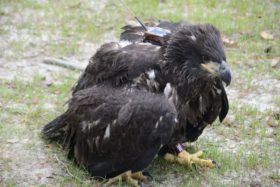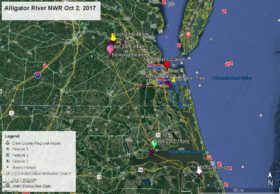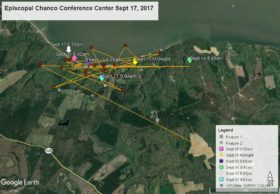Crop, Ears, Feather Tracts
Azalea back in Currituck County, NC
March 20, 2010Azalea Makes Quick Visit to Norfolk
March 23, 2010

Photo 1 – The Crop – Every day the question is asked “What is the crop?” In short it is a pantry or storage area below the chin that is filled when some birds (not all) eat. In the first photo above the eaglet on the right has a full “crop.” You can see it bulging out. In technical terms, it is an expandable section of the esophagus that is used to store and soften food and regulates the flow of food through the digestive tract.
Photo 2 – On March 3 I posted an article about eagle hearing and ears. In photo 2 above the ear hole on the eaglet in the middle shows clearly just behind its eye. Once its head feathers grow in you will no longer be able to see the ear. Also in photo 2 if you look closely at the eaglet laying down on the right you will notice that the down on its back (see March 18 article about down) is in rows. These rows are called feather tracts. There are 8 major feather tracts on birds that are divided into about 100 groups. These feather tracts are connected by a complex system of nerves and muscles that allow the eagle to control and move its feathers as needed for insulation, preening, flight and all other purposes.
Click photos to enlarge.




7 Comments
These additional insights are very helpful! I hope that you were able to capture this morning (Monday, 22 March)’s team feeding, with both mom and dad on the nest at the same time, with dad “carving” and feeding one chick and also passing bits on to mom, who was feeding mostly the other two….would love to see that sequence again! Their cooperation as a parental unit and control of those huge scimitar-like beaks says a lot about why these birds have managed to survive.
WOW Reese, this is absolutely fantastic that we can now “see” what we’ve wondered about. How cool that these photo’s have allowed us to view all of it. That’s a “big” crop on that baby!!! Thanks for the clarifications…..
Reese, so many thanks! Without you, I would never have seen an eagle’s ear! You are so knowledgeable and share your gift so well. Hearing or reading about it is one thing, but actually seeing it on “one-of-our-own” is fantastic.
Reese, what interesting information. I love to read your blogs. You not only tell us, but show us too. Thanks for sharing your knowledge with us.
Such interesting information! And pictures too! Thanks so much for pointing this out. Reading about it and having pictures to go along with the info is great. Everything about these wonderful birds is fascinating. I am enjoying learning! Thank you!
Reese, as a retired teacher myself, may I compliment you on your teaching! I sense your joy when you share your knowledge and experience with others and “open up a new world” for them. Your enthusiasm for what you do is engaging and your patience is incredible. At least I could wait for another year and a new class to reteach. You do it constantly as excited new learners join us daily. YOU ROCK!
Dollyrag – Thank you for your comments. This eagle cam is by far the best opportunity to educate people about bald eagle ecology. Now we need to get more folks reading these postings and not just looking at the web cam.